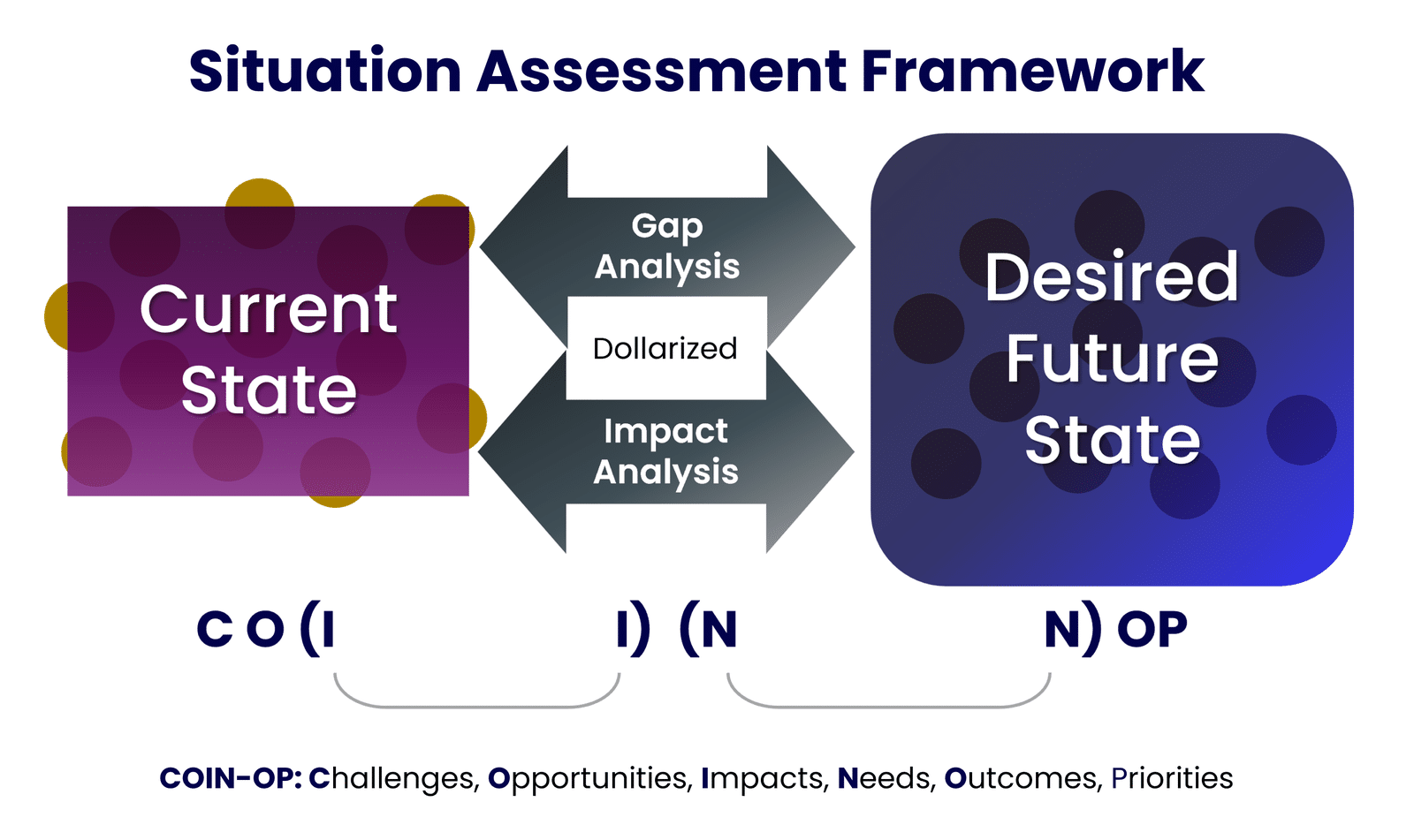B2B buying research studies consistently report that modern buyers are disappointed with their seller counterparts. There are multiple reasons for this, but some common themes reported by buyers include:
- Sellers don’t understand the buyers, their company or their business issues.
- Sellers act in seller- and product-centric ways and rush to present – or worse, pitch.
- Sellers do not communicate well with the buyers’ senior leaders, or the decision makers and influencers on the buying committee.
- Sellers do not deliver insights, perspective, expertise and helpful content to better inform the buying decision.
It’s an unfortunate truth that I could add to this list, but I’ll stop here because the root cause of these issues can be overcome simply by:
- Conducting better discovery, meaning a buyer-centric situation assessment.
- Acting appropriately based on what is learned during discovery.
- Exercising professional patience throughout the discovery process, to avoid presenting prematurely.
These are simple solutions with a significant potential for impact, when done well. One might even say that they are the superpowers of selling.
Let’s explore.
The Superpower of Discovery – Situation Assessment
Discovery, as it relates to selling, is a term that has been around for many years.
Sales discovery is the process of learning about a potential customer’s challenges, opportunities, needs and preferences to tailor a presentation or recommendation to their specific situation. It is an essential part of the sales process, as it allows salespeople to understand the customer’s context and create personalized and relevant solutions.
With buyer-centric sellers, it’s conducted as a process to discover what is important to prospective customers and uncover how the seller can best serve them. Unfortunately, for some sellers, perhaps the ones who caused buyers to form and report the opinions shared at the beginning of this article, it means to look for any opening to pounce and pitch their products.
I refer to the act of discovery, conducted with buyer-centric intentions, as a situation assessment. This is what I’ve seen the elite sellers do, over many years of conducting top performer analysis. It’s what we included in our Modern Sales Foundations course, for that exact reason. Done well, it’s not only very helpful for the seller, but is also a valuable service to the buyers.
Discovery Planning
Great sales discovery isn’t something that just happens. It’s a thoughtful action that requires good planning.
- If you sell a simple solution that solves a common or consistent problem for your customers, the planning may be front-loaded to design a good process that you then run each time, in the same or similar way.
- If you sell more complex solutions that address more complex problems, you may need to do additional advanced research each time, develop separate discovery plans for each solution you offer, or even develop a branched process based on what you learn as you progress through your discovery.
In both cases, sales call planning is key.
Here’s another nuance, the starting point may vary as well, based on the source of the lead. You’ll always want to adapt your approach based on where the buyers are in their overall customer lifecycle or buyer’s journey. Imagine the difference between:
- A lead who has reviewed your website in detail, downloaded multiple gated assets and attended a recent webinar.
- Someone you have recently contacted through proactive outreach and set an appointment for a discovery meeting, based on their initial interest and curiosity when you spoke.
- A current customer for product [X], who is now exploring product [Y].
While a thoughtful situation assessment is done for the prospect as much as the seller and shouldn’t only be done to learn if you can sell something, at some point, you do need to determine if you can help.
When doing your upfront planning, whether it’s once (for the simplest, repeatable discovery process) or each time (for the more complex situations), this chart will help you plan questions to connect the dots between the customer’s situation and how you can help. I’ve often helped sellers get started with the thinking in this chart. Think of it as being needed and important, but not sufficient. You move from left to right as you plan, and from right to left as you execute.

The situation assessment framework itself offers another key opportunity for planning, with its current stage/desired future state structure and the COIN-OP acronym (Challenges, Opportunities, Impacts, Needs, Outcomes and Priorities).

The idea is to:
- Plan questions to uncover the challenges and opportunities in the current state, gathering the impacts of not solving the challenges or not capitalizing on the opportunities.
- Plan how you will ask about and detail the desired future state, especially the desired outcomes and the priority of those outcomes.
Discovery Execution
With the above preparation done, it’s all about executing your plan, listening well, recording or taking good notes on key information shared, and adapting along the way, based on what you learn.
- With the current and desired future states captured as suggested above, it allows you to conduct a gap analysis, by documenting the difference between the states and deciding what it would take to close the gap. Those capabilities, things or actions become the buyer’s needs (what they need to close the gap).
- Lastly you can conduct an impact analysis to document the reduction of negative impacts or risks in the current state, and the positive impacts of achieving the outcomes in the desired future state. This allows you to build a rational business case. To include the emotional aspects, you can consider the pain of change (there’s always some) and tie the reduced or eliminated Impacts and the achieved outcomes to what it means for the buyers and how it will feel.
- Note: Later, once you discuss solutions and costs, you can then compare the costs to the gains and project the return on investment (ROI) of your recommended solutions.
This framework is a powerful consulting method that works exceptionally well for modern, professional, consultative B2B selling. It is value focused and outcome oriented, with a deep buyer-centric focus and foundation. And if you look back at the buyer perceptions listed at the beginning of this article, you’ll notice that it addresses many of the concerns or lays the foundation to address them.
The Superpower of Patience
You’ll also notice that so far, there has not been a single mention of products, services or solutions. This is purposeful, based on those stated negative buyer perceptions of sellers. It’s where patience comes in. Like a physician who diagnoses before she prescribes, professional sellers know that it makes sense to hold back, even when they see a problem that they think they can solve. Sellers need to fully understand the buyers, their issues, the root causes, metrics that matter most, and their reasons, motivations, concerns and risks before presenting solutions that miss the mark. Or equally damaging, presenting the right solutions in a way that misses the mark.
Sidebar: As mentioned before, this may be contextual. If the buyer has approached you based on your solution or their advance research, you can adapt somewhat based on their interest or questions, as long as you don’t forgo completing the situation assessment or shift into full presentation mode.
When It’s Time to Recommend
This goes a bit beyond the scope of this post but it’s an important element to help understand “the why” behind discovery done this way, with a heavy dose of patience.
What you learn during a situation assessment influences both your choice of solution and how you present it. If you conduct a great situation assessment, you’ll be able to:
- Recommend a solution that addresses the root cause problem and delivers the intended outcomes.
- Position the solution in a relevant, compelling way, using the buyers’ own words based on their value drivers, such as business, experiential, aspirational or personal needs.
- Connect the dots about how your solution will address the impacts and outcomes that matter most.
- Develop a true business case for any financial decision makers.
Closing Thoughts
I’ve written this post to illustrate the more detailed discovery required for consultative selling. For the many distributors that offer complex, bespoke or engineered solutions, this is a perfect fit. But even if your company offers simpler products in a more transactional sales process, many of the concepts in this post can still work for you, when scaled down to be relevant for your situation and your customers. I’ve seen discovery sessions that span multiple hours over consecutive meetings, and I’ve seen it done at a counter in a matter of minutes.
In both cases, you can significantly differentiate yourselves and your company by asking thoughtful, well-planned questions to understand your prospects and customers better than anyone else, and ensure you deliver the exactly right products and services positioned in a way that resonates.
And that’s about as close to a superpower as you can get.
Well, that’s it for this post. If it helps you in any way on your journey toward improved sales effectiveness, please feel free to let me know. I’d enjoy hearing about your successes.
Mike Kunkle is an internationally recognized expert on sales enablement, sales effectiveness, sales training, sales coaching, sales management, and sales transformations.
He’s spent over 30 years helping companies drive dramatic revenue growth through best-in-class enablement strategies and proven effective sales systems.
Mike is the founder of Transforming Sales Results, LLC where he designs sales training, delivers workshops, and helps clients improve sales results through a variety of sales effectiveness practices and advisory services.
He collaborated to develop SPARXiQ’s Modern Sales Foundations™ curriculum and authored their Sales Coaching Excellence™ and Sales Management Foundations™ courses.
Mike's book, The Building Blocks of Sales Enablement, is available on Amazon, with others coming soon in 2026, starting with The CoNavigator Method for B2B Selling.

